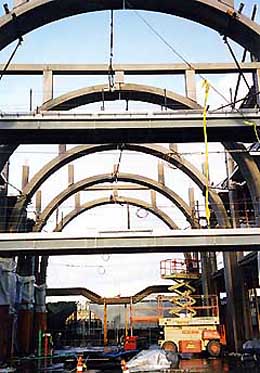On February 4, 2002, a ribbon-cutting ceremony marks the opening of Everett Station, an innovative civic facility that combines a multi-modal transportation center with college classrooms, employment services, community space, and city offices. The award-winning building with a brick and glass exterior, copper roof, four-story lobby, and art-filled interior brightens an industrial area of Everett east of downtown. The station brings bus service from Everett Transit, Snohomish County's Community Transit, regional Sound Transit, and Greyhound together in one location. Over the next two years, the buses will be joined by Amtrak and Sound Transit trains. The University Center at Everett Station provides the first local four-year college degree programs for Everett and Snohomish County residents.
Buses, Trains -- and Classrooms
Planning for Everett's new transportation center began nearly a decade before it opened. Everett Mayor Ed Hansen, first elected in 1994, refined the plans and was credited as a driving force behind the project. Hansen saw the concept of combining education with transportation -- derived from a similar project in Oakland, California -- as Everett Station's key component. The bachelor's and master's programs, offered by a consortium consisting of the University of Washington, Washington State, and Eastern, Central, and Western Washington universities, filled a gap for Everett and Snohomish County, which until 2002 was the largest population center in the state not home to a four-year college program.
In order to combine train and bus service at one location, Everett Station was built east of downtown (where the city's prior bus depot had been located), on Smith Avenue next to Burlington Northern Santa Fe's main rail line. The four-story building, designed by Zimmer Gunsul Frasca Partnership and built by Wilder Construction Company, cost $26 million. Acquiring and clearing the land brought the total project cost to $44 million. Federal, state, and local agencies, including Amtrak and Sound Transit, all contributed to the project, which also relied on some private funding. The City of Everett took the lead role, with executive administrator Paul Kaftanski managing the project.
Construction kicked off with a groundbreaking ceremony in July 2000. After more than 18 months of work, the ribbon-cutting on February 4, 2002, celebrated Everett Station's opening. Mayor Hansen, who presided as master of ceremonies, was joined by Governor Gary Locke (b. 1950), U.S. Representative Rick Larsen (b. 1965), Snohomish County Executive Bob Drewel, and Sound Transit board chairman (and King County Executive) Ron Sims (b. 1948) at the celebration. Praising the station's impressive brick and glass construction and the artwork scattered throughout its interior and landscaped grounds, the governor declared "All I can say is wow" (Fisher).
Art Old and New
Among Everett Station's highlights were a three-story glass wall, an atrium featuring soaring arches and a terrazo floor with a design representing Snohomish County waterways, a steel and stained-glass clock standing two stories high, and modern sculpture in the exterior gardens. The station's most important art was not new. A set of murals by acclaimed Northwest painter Kenneth Callahan (1905-1986) representing the history of logging in Everett were permanently displayed on the upper floors. The Weyerhaeuser murals had been donated to the city in 1974 but remained in storage until Everett Station provided a venue for them.
The station's first floor, with the great four-story lobby, contained ticket counters and waiting areas for bus and train passengers. Everett Transit's local buses and Community Transit's commuter buses began serving Everett Station when it opened on February 4, 2002. Greyhound long-distance service and Sound Transit's regional bus routes were in place soon thereafter. Train service took a little bit longer. Amtrak, which signed a 20-year lease with the city, was expected to begin serving Everett Station in July, but it was not until November 2002 that the national passenger rail company completed the move from its former Bond Street station near Everett's waterfront to the new transportation hub. It was another year, following difficult negotiations with Burlington Northern for track usage, before Sound Transit was able to begin its Sounder commuter rail service between Everett Station and Seattle, with one weekday train in each direction. In 2009 Sounder service includes a stop in Edmonds and another in Mukilteo and makes four round trips per weekday.
Award Winner
Above the transit center, University Center at Everett Station began classes in March 2002 in the second-floor classrooms. Later that spring, Worksource, a local arm of the state Employment Security Department began providing career development training and job placement assistance to the unemployed in the station. Two years later, Worksource expanded, leasing additional third-floor space that was the last remaining vacancy in the 64,000-square-foot building. In addition to University Center and Worksource, the building housed a city customer-service center. The fourth floor of Everett Station provided 2,800 square feet of community space, including kitchen facilities, for special events.
Everett Station has won several awards. In 2003, it was one of the Puget Sound Regional Council's VISION 2020 award winners. In 2006, Everett Station received a Citation Award from the state chapter of the American Institute of Architects (AIA), one of ten Civic Design Awards handed out by AIA Washington. The AIA jury said:
"[T]his transportation center .... houses an innovative mix of transit, educational functions, and community spaces; delights travelers; and is welcoming to the public for classes, public meetings, and banquets ... This elegant and monumental building wisely anticipates a less automobile-dependent future" ("AIA Washington ...").

